Features
In the summer of 2015, Peter Frankopan published his book The Silk Roads: A New History of the World, described by Bloomsbury as ‘a major reassessment of world history in light of the economic and political renaissance in the re-emerging east’.
Just three-and-a-half years later, the book has been named one of the 25 most important works translated into Chinese over the past 40 years. The Silk Roads takes its place on the list alongside literary classics including Pride and Prejudice, The Great Gatsby, Catcher in the Rye and One Hundred Years of Solitude.
Professor Frankopan, Professor of Global History at Oxford and Senior Research Fellow at Worcester College, described himself as ‘flabbergasted’ to be chosen for the list, which was compiled by Amazon China on the 40th anniversary of Chinese reform and opening-up.
He said: ‘When I was told about it, I thought it was a wind-up. Many of the books on the list are ones I admire hugely, and to be mentioned in the same breath as The Great Gatsby, One Hundred Years of Solitude, or A Brief History of Time is genuinely astonishing. I realise that tastes come and go, so who knows if it will still be mentioned in 25 years’ time. But it is a great testimony to the importance of the humanities in general, of history, and of the impact that historical writing can have far beyond the Senior Common Rooms of Oxford.’
The Silk Roads challenged Eurocentric views of world history, shifting the focus east of the Mediterranean. It became a bestseller in a host of countries and categories, and was met with widespread acclaim. A follow-up work, The New Silk Roads, was released last year and explores more recent events.
In Professor Frankopan’s own words, by writing The Silk Roads he was simply ‘trying to explain how the past looks from the perspective of the Eastern Mediterranean, Middle East, Central Asia and beyond’.
He added: ‘I’ve been a Senior Research Fellow at Worcester for nearly 20 years, and Director of the Oxford Centre for Byzantine Research since it was founded nearly a decade ago. I simply wanted to explain why the regions, peoples and cultures that I work on are not just interesting, but also important. It was not easy to write at all and I spent many, many late nights at my computer trying to work out if it was possible. I never thought for a moment about whether lots of people would read it. But I did think it was worth trying to write!’
Reflecting on the book’s success, Professor Frankopan – who has just published an illustrated version of The Silk Roads for younger readers – said: ‘It’s been a lovely – if sometimes strange – experience. This week alone, I’ve had tweets or Instagrams from people sending pictures of my book from bookshops in Norway, Indonesia, Nigeria, India and Pakistan, and lots of emails from all over the world, often asking questions about what to read next, or for more information about a specific location, which I always try to answer if I can. But I don’t think it has affected me – we have four children, who do a pretty good job in keeping my feet on the ground. And because, like most academics, I always have deadlines for articles or chapters in books, there’s never a great deal of time to bask in the sunshine as I’ve got too much to be getting on with as it is.’
By Amy Hinsley, Department of Zoology
It is widely accepted that many conservation challenges are directly related to human behaviour. Whether it is the over-collection of a rare orchid by harvesters in Southeast Asia, or the decisions by collectors in Europe to buy and smuggle these orchids home, understanding the extent and nature of these behaviours is essential to addressing the threats they might cause. This has led conservation researchers and practitioners to start looking outside of their discipline, to find methods and approaches from across the social sciences to improve our understanding of these complex issues.
Whilst this interdisciplinarity is a positive move for conservation, it is important that we treat these ‘new’ methods carefully and understand their limitations. If we don’t, there is a risk that our new toolbox full of exciting methods that sound great on a funding application, may in fact not be making what we do any better, or in extreme cases they may even be making it worse.
The Unmatched Count Technique
With this in mind, a group of conservation social scientists, led by researchers at the universities of Oxford and Exeter, decided to look in depth into one of these ‘new’ methods, to provide recommendations on when and how it should be used, and when it shouldn’t. The paper, freely available in the journal Methods in Ecology and Evolution this week, looks at the Unmatched Count Technique (UCT - also called the list experiment), which is increasingly being used in conservation to ask questions about sensitive topics.
The method asks questions in an indirect way that allows the respondent to remain protected and anonymous, meaning that it should produce more truthful answers. So far it has mainly been used to investigate topics that people might be tempted to hide their association with, including illegal behaviours (e.g. stealing), but also those that somebody might be embarrassed to admit openly to a researcher, such as socially undesirable (e.g. racist views), or very personal topics (e.g. being HIV positive). It can also be used to find out how many people really support or participate in socially desirable behaviours that might be exaggerated to impress people, such as recycling or turning out to vote.
The team reviewed all peer-reviewed studies that had used UCT and, along with insights from their own experiences using it, developed a set of guidelines. We found that, since UCT was first developed in 1979, it has been used in more than 50 countries and several disciplines.
Impressed by the potential of the method, conservationists started using the UCT in 2013, and it has been growing in popularity ever since, with five peer-reviewed conservation studies using it in 2017 alone.
How does it work?
One of the biggest draws of the UCT is that is looks so easy – UCT questions consist of a short list of items, and respondents are asked to report how many are true for them. These lists can also include drawings to make it more appealing and easier to understand, especially where literacy levels are low.
A random 50% of respondents are shown a list of only non-sensitive items (shaded blue in this example below about international illegal orchid trade), whilst the other half see a list with an additional sensitive item (shaded yellow).
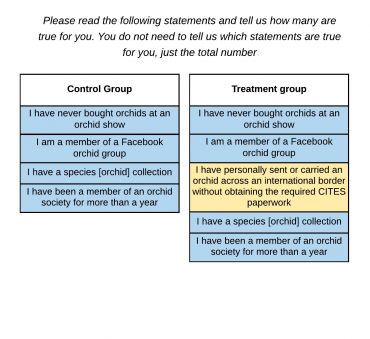 Example UCT questions
Example UCT questionsOur research shows that social science methods from outside of conservation are useful and we should not stop trying to increase the range of techniques available that can improve how we do conservation. However, we also have to accept that as well as benefits from the use of a new method there will be also be a responsibility for us to investigate its potential limitations, and put in the work required to do it well.
Read the full paper: 'Asking sensitive questions using the unmatched count technique: Applications and guidelines for conservation', Methods in Ecology and Evolution.
Dr Toby Young, Gianturco Junior Research Fellow at Linacre College, writes for Arts Blog about the Displaced Voices project. Read the previous blog post on Displaced Voices here.
Displaced Voices is an initiative that brings together school and university students with the professional musicians of the Orchestra of St John’s, community members, refugees and asylum seekers through musical collaboration, and raises awareness about refugee issues in Oxfordshire through the medium of artistic expression. Together with conductor, researcher and activist Dr Cayenna Ponchione, I have been working over the past term with four creative, intelligent and emotionally mature refugee students from the Oxford Spires Academy to help give voice to their lived experiences of forced migration.
Through the creation of live orchestral ‘backing tracks’ to underscore spoken word performance of their own poetry – developed as part of an award-winning poetry programme developed by Kate Clanchy – we have been exploring how music might help magnify the strong emotional content of these unique and moving stories, creating a musical experience somewhere akin to the accompaniment of a rousing or emotional speech in film music. As well as offering technical and aesthetic discussions of the ways in which music can support, enhance or even subvert spoken text, our group sessions have involved a certain amount of discussion about the student’s experiences. Even reflecting on these stories now, months after first hearing their shocking accounts of living in brutally war-torn countries and undergoing distressing journeys to seek protection in the UK, gives me chills.
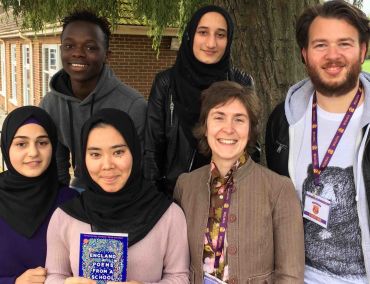 Dr Toby Young and Dr Cayenna Ponchione-Bailey with students from Oxford Spires Academy.
Dr Toby Young and Dr Cayenna Ponchione-Bailey with students from Oxford Spires Academy.As well as a direct collaboration on the students' spoken performances, I have been writing my own setting of one of the student’s poems to be sung by the mezzo-soprano Charlotte Tetley. Compared to my other experiences of working with text (by both historical and living writers) this process has thrown up a lot more challenges: for example, techniques and methods I might have used to engage with to texts in the past – perhaps by trying to empathise with the text through connection to my own lived experiences (in this case my homesickness or experience of injustices), or by trying to think of the poem as a sort of atmospheric backdrop to key words or phrases – feel unethical and unfair. These stories are hugely personal and poignant to the students, with every word being critical for an authentic and unfiltered representation of their stories in specifically the way they need to be told. In contrast to historical texts where adding my own meaning, experience and ownership to a text is taken for granted, my role here is of translator, not re-interpreter.
Running alongside the creative component of Displaced Voices is a research project that seeks to methodically and critically understand the impact of these activities and concerts on not only the students, but also other individuals who might come into contact with the music (for example the orchestral musicians, teachers, audiences and so on). As well as trying to evaluate how effectively students feel that the music has enhanced or detracted from the emotional meaning of their poems, we are interested in understanding how the whole process – both the challenges and rewards – might impact on the students’ lives. Watching the students’ develop into confident and talented young public speakers has been truly inspirational, and seeing how music has afforded them an increased confidence in their stories and identities has been deeply moving. Through this and future projects, it is our hope that we are able to help support the development of these unique young people as future leaders and agents of social change, amplifying their powerful stories to new parts of society so that their experiences might help those in power to better consider how they might support the cultural integration and wellbeing of young migrant children all over the country.
To date no research has been conducted on an orchestral engagement project like this one, and it is our hope that the findings of this study will inspire and inform other orchestras to create similar projects. I cannot emphasise enough how strongly I recommend other organisations consider using the methods we have piloted here to engage with refugee and migrant communities near them. It has been one of the most inspiring, moving and valuable experiences of my life, and I leave the process a transformed musician and human being.
Displaced Voices will be performed in Somerville Chapel, Oxford on 18 January, preceded by a panel discussion exploring the issues facing refugees in the UK and a showcase of poetry on the subject of displacement, migration and home. For further information, and to book, click here.
A new device could enable computers that use optics and electrical signals to interact with data
Researchers from the universities of Oxford, Exeter and Münster have demonstrated a new technique that can store more optical data in a smaller space than was previously possible on-chip. This technique improves upon the phase-change optical memory cell, which uses light to write and read data, and could offer a faster, more power-efficient form of memory for computers.
In Optica, The Optical Society's journal for high impact research, the scientists describe their new technique for all-optical data storage, which could help meet the growing need for more computer data storage.
Rather than using electrical signals to store data in one of two states - a zero or one - like today’s computers, the optical memory cell uses light to store information. The researchers demonstrated optical memory with more than 32 states, or levels, the equivalent of 5 bits. This is an important step toward an all-optical computer, a long-term goal of many research groups in this field.
Research team leader Harish Bhaskaran from Oxford University’s Department of Materials said: ‘Optical fibres bring light-encoded data to our homes and offices, but that information is transformed to electronic signals once inside computers. By bringing the speed of light-based data transmission to the circuit boards that run computers, our all-optical memory could enable a hybrid computer chip that interacts with data both optically and electrically.’
The new work is part of a large project called Fun-COMP, for Functionally-scaled Computing technology, that brings academic and industrial partners together to develop groundbreaking hardware technologies.
Writing data with light
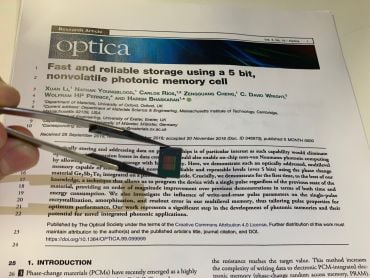 optica detail
optica detail
The optical memory cell uses light to encode information in a phase change material, a class of materials used to make re-writable CDs and DVDs. A laser heats portions of a phase change material, which causes it to switch between states where all the atoms are ordered or disordered. Because these two states exhibit different optical indices of refraction, the data can be read using light.
Phase change materials can store data for a long time because they remain in the disordered or ordered state until illuminated again with the specific type of laser light originally used to write the data. Mixing different ratios of ordered and disordered states in an area of the material allows information to be stored in a continuum of levels instead of just a zero and a one as in traditional electronic memory.
The researchers accomplished the increased resolution by using a new technique they developed that uses laser light with a single, double-stepped pulse — two pulses put together into a rectangular-shaped pulse — to precisely control the melting and the crystallisation of the material.
Multi-level memory storage
The researchers showed that they could use their approach to reliably encode data on 34 levels, which is more than the 32 levels necessary to achieve 5-bit programming.
‘This accomplishment required understanding the interaction between the light and the material perfectly and then sending exactly the right sort of laser pulse necessary to achieve each level,’ said Bhaskaran. ‘We solved an extraordinarily difficult problem.’
The new technique could help overcome one of the bottlenecks limiting the speed of today’s computers: the link between the processor and the memory. ‘A lot of work has gone into improving the communication between these two units using fiber optics,’ said Bhaskaran. ‘However, linking these two units optically still requires expensive electro-optical conversions at both ends. Our memory cell could be used in a hybrid optical-electrical setup to eliminate the need for that conversion on the memory side by allowing data to be stored and retrieved optically.’
Next the researchers want to integrate multiple memory cells and individually program them, which would be required to make a working memory chip for a computer. The research groups have been working closely with Oxford University Innovation, the University’s innovation arm, to develop commercial opportunities arising from their research on photonic memory cells. The researchers say that they can already replicate the devices extremely well but will need to develop light signal processing techniques to integrate multiple optical memory cells.
'What are you going to do with a degree in Classics / English / Maths?' is a common question, often from parents, and particularly when compared with apparently more vocational degree subjects. The question becomes particularly loaded when the prospective student is from a non-traditional background, and perhaps is the first in their family to consider going to university.
Analysis of the first career destinations of the Oxford undergraduates who left in 2017, shows that there is no statistically significant difference in career outcome associated with any of seven different measures of social background. This result is contrary to the national picture; it also confirms the result that we found for the Oxford leavers of 2015.
By career outcome, we used three measures: the proportion of students unemployed and looking for work, the proportion in a 'graduate-level' job, and the average starting salary. While there are, of course, other measures of career success, including satisfaction, happiness, feeling of doing something worthwhile, and intellectual challenge, all of these are difficult to quantify – so we use what is widely and reasonably reliably available. The career measure is taken from the Destination of Leavers from Higher Education (DLHE) survey of all leavers, six months after leaving. Again, we all recognise that higher education can equip graduates with life skills – and surveying five, 10 or 20 years later would be more helpful. As an aside, the DLHE is now changing to a Graduate Outcomes Survey, taken 15 months after leaving.
By social background, we used seven measures: two post code assessments (ACORN, a postcode-based tool that categorises the UK's population by level of socio-economic advantage; and POLAR, a similar tool that measures how likely young people are to participate in higher education based on where they live); ethnic background (black and minority ethnicity (BME) and white); school type (state and independent), Oxford's 'Widening Participation' (WP) flag (which is used to determine students who are from disadvantaged backgrounds); Oxford bursary holders; and household income (£0-£16,000, £16,000-£25,000 etc.).
Effectively we found no association between social background and initial outcome. While there are some differences in starting salary for some groups (for example, a higher proportion of BME students than of white students, start work in higher paying sectors such as banking and consulting), once the analysis controls for the industry sectors each group enter, that difference is not significant.We analysed whether there was any statistically significant difference in the three outcome measures (unemployment, graduate-level work, average salary) for the different populations of students on all seven measures. For example, BME versus white students, state versus independent school students, WP-flag versus non-WP-flag students, and so on. We ran the analysis for the whole University of Oxford and for each division (Medical Sciences; Maths, Physical & Life Sciences; Social Sciences; and Humanities) separately.
In particular, it's worth noting that there is no difference in outcome for students from households with incomes below £16,000 per year versus everyone else.
This is a very welcome and reassuring result of which Oxford can be rightly proud. The University can confidently tell all prospective students, regardless of their school type, ethnic group, postcode, or household income, that their career prospects are not significantly affected by their background.
At Oxford, the answer to the opening question, 'What are you going to do with a degree in Classics / English / Maths?' is 'almost anything.'
Jonathan Black is the director of Oxford University's Careers Service.
- ‹ previous
- 57 of 248
- next ›

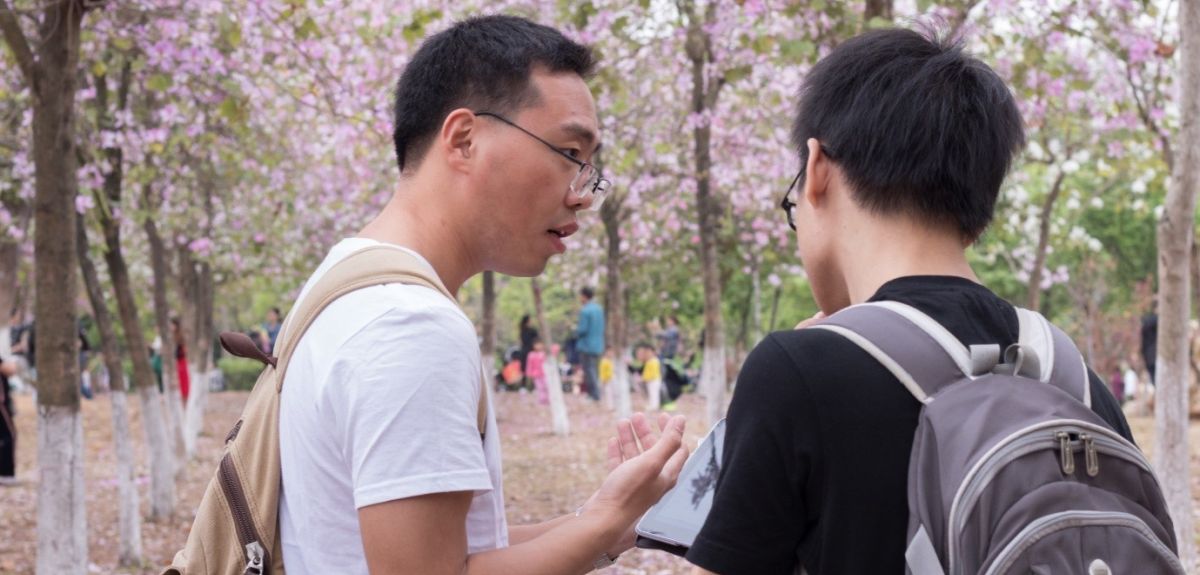
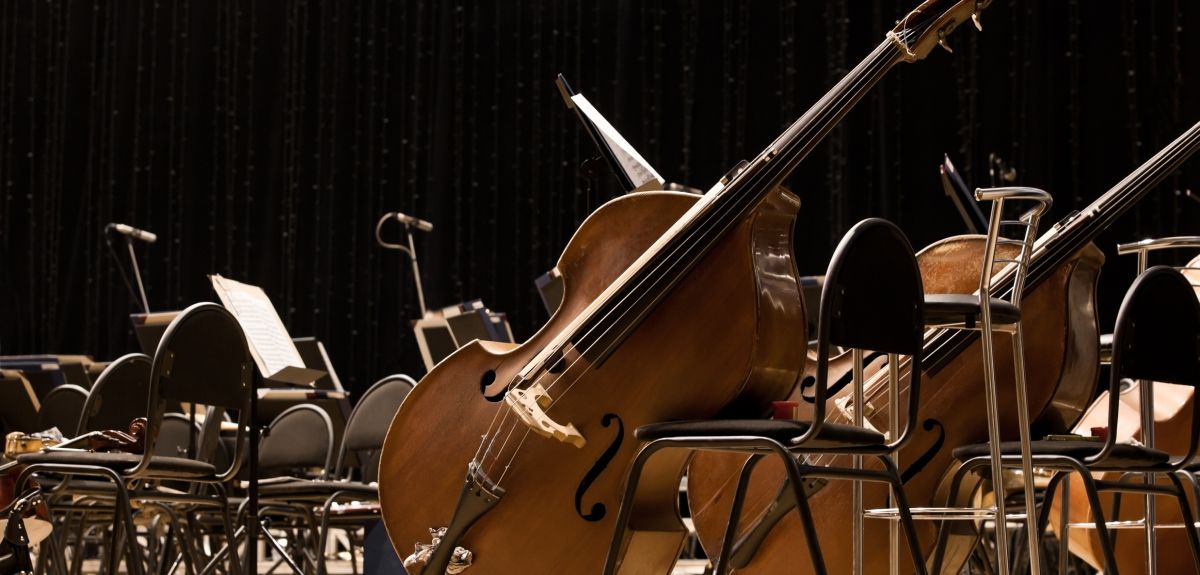
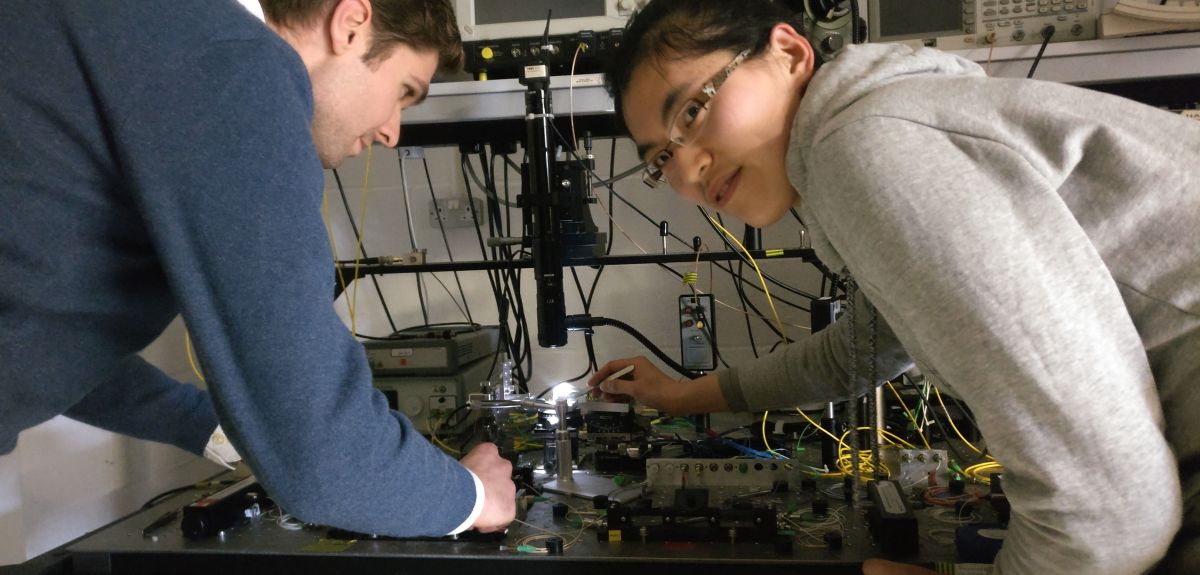

 Teaching the World’s Future Leaders
Teaching the World’s Future Leaders  A blueprint for sustainability: Building new circular battery economies to power the future
A blueprint for sustainability: Building new circular battery economies to power the future Oxford citizen science project helps improve detection of antibiotic resistance
Oxford citizen science project helps improve detection of antibiotic resistance The Oxford students at the forefront of the fight against microbial resistance
The Oxford students at the forefront of the fight against microbial resistance  The hidden cost of AI: In conversation with Professor Mark Graham
The hidden cost of AI: In conversation with Professor Mark Graham  Astrophoria Foundation Year: Dr Jo Begbie reflects on the programme’s first year
Astrophoria Foundation Year: Dr Jo Begbie reflects on the programme’s first year World Malaria Day 2024: an interview with Professor Philippe Guerin
World Malaria Day 2024: an interview with Professor Philippe Guerin From health policies to clinical practice, research on mental and brain health influences many areas of public life
From health policies to clinical practice, research on mental and brain health influences many areas of public life From research to action: How the Young Lives project is helping to protect girls from child marriage
From research to action: How the Young Lives project is helping to protect girls from child marriage